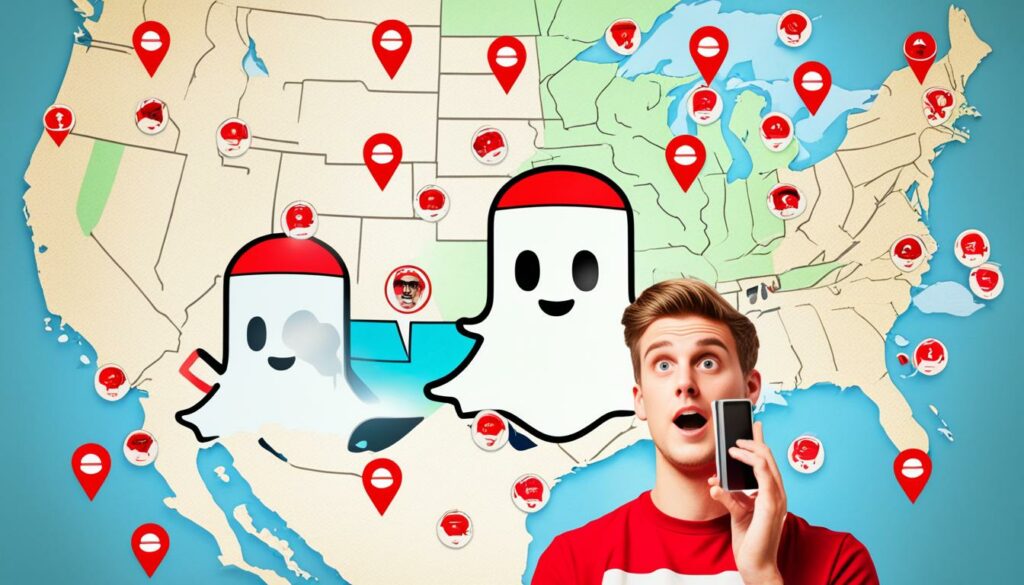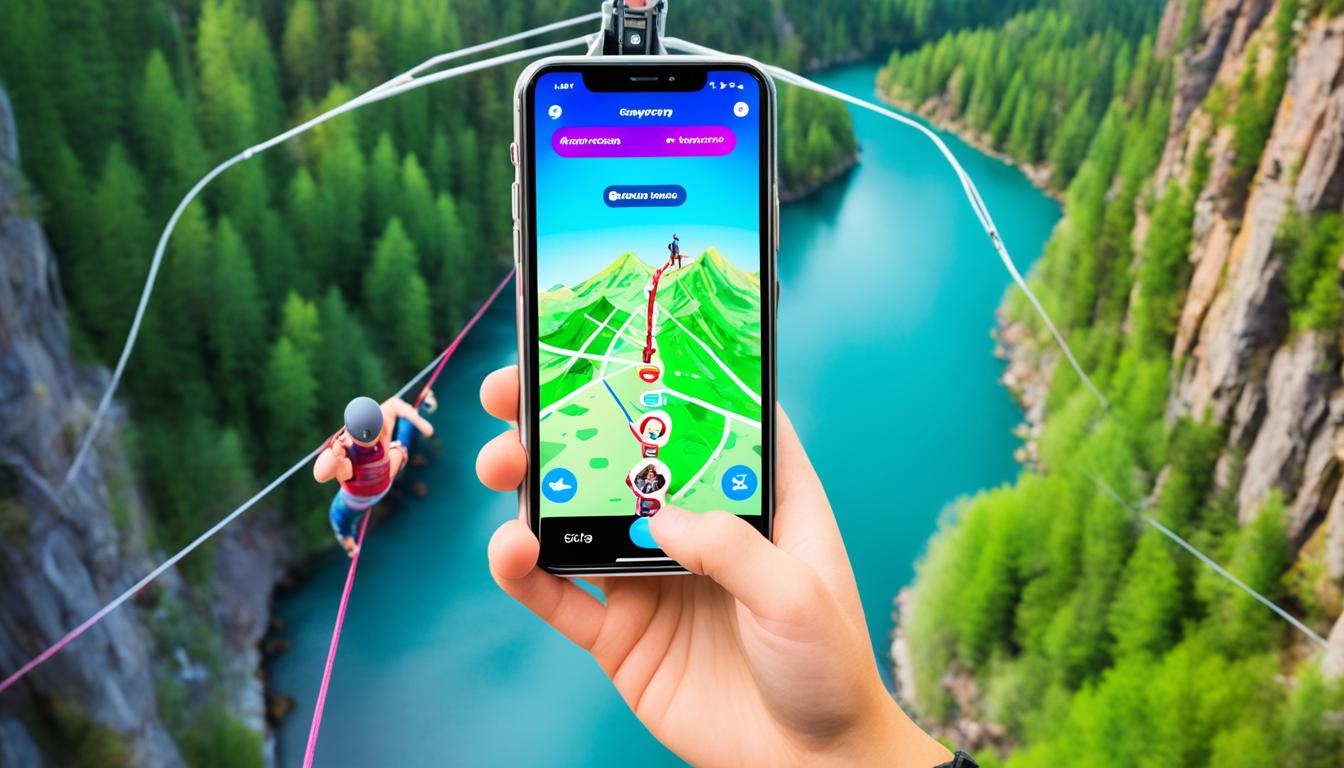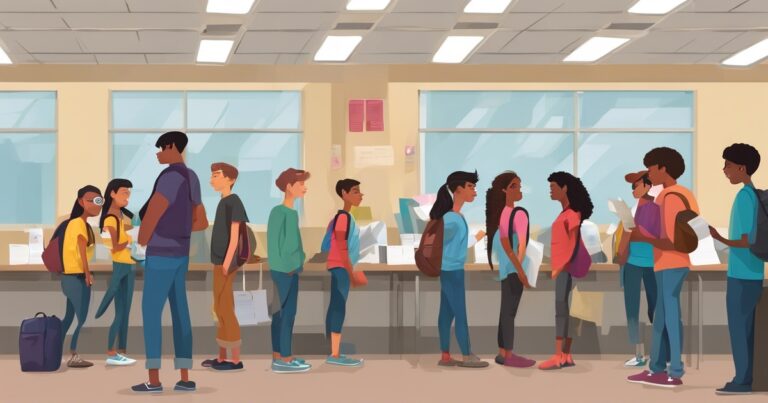Teens & Snapchat: Navigating Social Media Safely
Snapchat has become a popular social media platform among teenagers, offering a unique way to connect with friends, express creativity, and share personal moments. However, it is crucial for both teens and parents to understand the safety concerns associated with Snapchat and how to navigate the app responsibly.
Key Takeaways:
- Teens can benefit from using Snapchat to stay connected with friends, express creativity, and share personal moments.
- However, parents should be aware of potential safety risks, including cyberbullying, inappropriate content, and encounters with strangers.
- Implementing parental control measures and having open communication with teens about responsible usage can help ensure their safety on Snapchat.
- Teens should be educated about online etiquette, privacy settings, and the importance of safe web browsing.
- Parents can guide their teens in using Snapchat’s AI features and understanding the data collection aspects responsibly.
What is Snapchat and How Does it Work?

Snapchat is a popular messaging app that allows users to send photos and videos, known as snaps, to their friends. The app is free to download and is available on both iOS and Android devices. Snapchat has gained immense popularity among teenagers due to its unique feature of disappearing snaps.
When using Snapchat, users can take a photo or record a video and then customize it with filters, effects, and captions. Once the snap is ready, users can choose the recipients and set a time limit for how long the snap can be viewed. After the recipient opens the snap, it disappears from their device, leaving no trace of the shared content. This temporary nature of snaps makes Snapchat an appealing platform for teens to communicate and share moments in a more spontaneous and casual manner.
However, it is essential for parents to understand the age restrictions associated with Snapchat. The app has an age restriction of 13 years old, but there is no age verification process in place. This means that teenagers can easily create an account without proving their age. It is important for parents to consider this age restriction and assess whether their teenager is ready to use Snapchat responsibly.
Despite its popularity and unique features, Snapchat has faced criticism for its potential privacy and safety concerns. It is crucial for parents to monitor their teenager’s Snapchat usage and have open conversations about responsible behavior online. By understanding how Snapchat works and its age restrictions, parents can make informed decisions about whether their teen should have Snapchat and provide guidance on its responsible usage.
Benefits of Snapchat for Teenagers
Snapchat is not just another social media app for teenagers; it offers unique benefits that appeal to this age group. Let’s explore how Snapchat positively impacts adolescent behavior and why it has become a popular platform among teenagers.
Staying Connected and Building Relationships
One of the key benefits of Snapchat for teenagers is the ability to stay connected with friends. With its interactive features and real-time communication, Snapchat allows teens to maintain strong relationships, even when physically apart. They can exchange snaps, videos, and messages, fostering a sense of closeness and connection.
Moreover, Snapchat’s private messaging feature enables teens to have intimate conversations, express support, and share personal experiences directly with their closest friends. This social aspect of Snapchat promotes positive social interaction and can help teenagers feel a sense of belonging within their peer groups.
Showcasing Creativity and Expressing Individuality
Snapchat offers a range of creative tools, such as filters, lenses, and captions, which allow teenagers to express their individuality and showcase their creativity. Through innovative photo and video editing features, teens can transform their snaps into unique visual representations of their personalities and interests.
By experimenting with different filters, adding captions, and using augmented reality effects, teenagers can unleash their imagination and create captivating content. This self-expression fosters self-confidence, encourages artistic exploration, and empowers teenagers to develop their own personal brand on social media.
Benefits of Snapchat for Teenagers
| Benefit | Description |
|---|---|
| Staying Connected | The app allows teens to maintain strong relationships with friends, even when physically apart. |
| Building Relationships | Private messaging and real-time communication features foster a sense of closeness and connection. |
| Showcasing Creativity | The range of creative tools enables teens to express their individuality and showcase their artistic skills. |
| Expressing Individuality | The app empowers teenagers to develop their own personal brand and explore their interests. |
While Snapchat provides numerous benefits for teenagers, it is vital for parents to monitor their teenager’s behavior on the platform. By actively engaging in conversations and setting guidelines for responsible usage, parents can ensure that their teens fully enjoy the benefits of Snapchat while staying safe.
Now, let’s delve into the safety concerns associated with Snapchat in the next section.
Image:
Safety Concerns of Snapchat for Teens

Snapchat is a popular platform among teenagers, offering them a fun and creative way to connect with friends and share moments. However, it is crucial for parents to be aware of the safety concerns that come with using Snapchat.
Cyberbullying: One of the risks associated with Snapchat is cyberbullying. The app allows users to send messages and media that disappear after being viewed, which can make it easier for individuals to engage in bullying behavior without immediate consequences. Teens may receive hurtful messages or be subjected to harassment through Snapchat, leading to emotional distress.
“Cyberbullying on Snapchat can have a significant impact on a teen’s mental health. It is important for parents to actively monitor their teen’s interactions on the app and encourage open communication.”
Inappropriate content: Another concern is the potential exposure to inappropriate content. While Snapchat has measures in place to prevent explicit content from being shared, it is not foolproof. Teens may come across inappropriate images, videos, or messages, which can be distressing or have a negative influence on their behavior and attitudes.
Encounters with strangers: Snapchat allows users to add friends by scanning their Snapcodes or searching for usernames. While this feature promotes social connections, it can also expose teens to strangers. It is essential for parents to educate their teens about the risks of interacting with unknown individuals online and to encourage them to only add people they know and trust in real life.
To address these safety concerns, parents should have open communication with their teens about the potential risks of using Snapchat. By setting clear guidelines and discussing responsible app usage, parents can help teens navigate Snapchat in a safer manner.
| Cyberbullying | Inappropriate content | Encounters with strangers |
|---|---|---|
| Can lead to emotional distress | Potential exposure to explicit content | Risks of interacting with unknown individuals |
| Parents should actively monitor interactions | Teens may come across inappropriate material | Encourage teens to only add trusted individuals |
| Open communication is crucial | Educate teens about the risks | Discuss responsible app usage |
Parental Control on Snapchat Usage

As a parent, it is important to establish parental control measures to ensure that your teens are using Snapchat safely. By implementing these measures, you can help mitigate potential risks and guide your teen’s behavior on the platform.
Setting Privacy Settings
One of the first steps in exercising parental control on Snapchat is to assist your teen in setting up appropriate privacy settings. This ensures that their snaps and personal information are only visible to trusted friends. Encourage your teen to set their account to private and limit who can send them snaps or view their stories.
Monitoring Activity
Monitoring your teen’s Snapchat activity is an effective way to oversee their usage and identify any concerning behavior. Regularly check their friends list and the content they are sharing to ensure they are engaging in appropriate interactions. Additionally, be vigilant for any signs of cyberbullying or suspicious contacts.
Discussion on Appropriate Behavior and Content
Engaging in ongoing conversations with your teen about appropriate behavior and content is essential for their safe usage of Snapchat. Set clear expectations about what is acceptable and unacceptable when using the app. Discuss the potential consequences of sharing inappropriate or sensitive information and encourage responsible digital citizenship.
“Engaging in ongoing conversations with your teen about appropriate behavior and content is essential for their safe usage of Snapchat.”
By implementing these parental control measures, you can support your teen in using Snapchat responsibly and safely. Open communication, active monitoring, and guidance are key to ensuring a positive experience on the platform.
| Parental Control Measures | Description |
|---|---|
| Set Privacy Settings | Ensure snaps and personal information are only visible to trusted friends by setting up privacy settings. |
| Monitor Activity | Regularly check your teen’s friends list and the content they are sharing to ensure appropriate usage. |
| Discuss Behavior and Content | Engage in conversations about appropriate behavior and content to promote responsible usage of Snapchat. |
By implementing these parental control measures, you can support your teen in using Snapchat responsibly and safely. Open communication, active monitoring, and guidance are key to ensuring a positive experience on the platform.
How to Report and Block Content on Snapchat

Snapchat provides users with various tools to report and block harmful or offensive content. It is important for teens to know how to utilize these tools and for parents to guide and educate their teens on reporting and blocking inappropriate content. By taking advantage of these features, users can create a safer and more enjoyable Snapchat experience.
Here are the steps to report and block content on Snapchat:
Reporting Content:
- Open the Snapchat app and navigate to the content you wish to report.
- Tap and hold on the content to bring up the options menu.
- Select the “Report” option.
- Choose the reason for reporting the content from the provided options.
- Follow any additional prompts or instructions provided by Snapchat.
Blocking Individuals:
- Open the Snapchat app and go to your Friends list.
- Locate and tap on the user you want to block.
- Tap on the three dots (…) next to their name.
- Select the “Block” option.
- Confirm your decision to block the user.
By reporting harmful content and blocking individuals who intend to harm others, users can contribute to a safer Snapchat community. Snapchat also provides additional features that allow users to filter the content they see, ensuring a more positive and enjoyable experience.
“Reporting and blocking inappropriate content enhances the safety of the Snapchat community and protects users from harmful interactions.” – Snapchat
To further enhance privacy and security, Snapchat offers comprehensive privacy settings and geolocation options. By educating teens about these settings, parents can help ensure a safer Snapchat experience for their children.
| Benefits of Reporting and Blocking Content on Snapchat | Steps to Report and Block Content |
|---|---|
| – Creates a safer and more positive Snapchat environment | 1. Open the Snapchat app and navigate to the content you wish to report. 2. Tap and hold on the content to bring up the options menu. 3. Select the “Report” option. 4. Choose the reason for reporting the content from the provided options. 5. Follow any additional prompts or instructions provided by Snapchat. |
| – Prevents harmful interactions and cyberbullying | 1. Open the Snapchat app and go to your Friends list. 2. Locate and tap on the user you want to block. 3. Tap on the three dots (…) next to their name. 4. Select the “Block” option. 5. Confirm your decision to block the user. |
| – Promotes responsible and positive online behavior |
Snapchat Privacy Settings and Geolocation

Protecting personal safety and privacy is of utmost importance for both teens and parents when using Snapchat. It is crucial to understand and customize the privacy settings available on the app to ensure a safe digital experience. By adjusting these settings, users can limit who can view their information and exercise control over their location sharing.
One essential privacy setting on Snapchat is geolocation. By turning off geolocation features, users can protect their personal safety and privacy by preventing others from accessing their real-time location information. This is particularly important for teenagers, as sharing their location with strangers can pose significant risks. It is advised to keep geolocation turned off by default to minimize potential vulnerabilities.
How to Adjust Privacy Settings on Snapchat
Reviewing and updating privacy settings regularly is a proactive measure to ensure that personal information is shared only with trusted friends on Snapchat. Here’s how to do it:
- Open Snapchat and go to your profile by tapping on the Bitmoji icon in the top left corner.
- Tap on the gear icon in the top right corner to access settings.
- Scroll down and find the “Who Can…” section to customize privacy preferences.
- Adjust settings for who can contact you, view your story, see your location, and more.
- Turn off geolocation by default or limit location sharing to a select group of trusted friends.
- Regularly review and update these settings to ensure they align with personal preferences and safety considerations.
By taking control of privacy settings, teens can protect themselves from potential risks while still enjoying the benefits of Snapchat’s social features.
Benefits of Snapchat’s Privacy Features
Snapchat’s privacy settings enable users to have a more secure and personalized experience on the app. By customizing these settings, teens can:
- Limit who can see their profile and contact them, reducing the risk of unwanted interactions.
- Control who can view their story, ensuring that personal moments are only shared with trusted friends.
- Decide whether to share their location and with whom, maintaining personal safety and privacy.
- Enhance privacy by enabling two-factor authentication, adding an extra layer of security to their account.
With these privacy features, Snapchat strives to provide users with a safe and enjoyable social media experience.
| Advantages | Disadvantages |
|---|---|
| Greater control over personal information | Potential limitation on connecting with new friends or discovering content based on location |
| Reduced risk of cyberbullying and unwanted attention | Challenges in managing privacy settings and keeping up with updates |
| Enhanced protection of personal safety | Possible limitations on sharing moments with a broader audience |
Secure Internet Connections and Safe Web Browsing
To enhance online safety, it is crucial for teens to prioritize secure internet connections and practice safe web browsing. One important step is to avoid using public Wi-Fi connections when accessing websites that require a password. Public Wi-Fi networks can be vulnerable to hackers and identity theft, putting sensitive information at risk.
Instead, teens should consider the following tips for secure browsing:
- Limit social media usage to personal or private Wi-Fi networks: Using trusted and secure Wi-Fi networks, such as those at home or through a trusted mobile provider, reduces the chances of unauthorized access to personal information.
- Utilize cellular data: When Wi-Fi networks are not available or considered unsafe, using cellular data can be a more secure alternative for browsing the internet.
- Utilize a Virtual Private Network (VPN): A VPN can provide an additional layer of security by encrypting internet traffic and masking the user’s IP address, making it difficult for hackers to intercept data.
It is essential for teens to be aware of the risks associated with using public Wi-Fi and take precautions when browsing the web. By practicing secure internet connections and safe web browsing habits, teens can protect their personal information and navigate the online world with confidence.
| Secure Internet Connections and Safe Web Browsing Tips |
|---|
| Avoid using public Wi-Fi networks when accessing websites that require a password. |
| Limit social media usage to personal or private Wi-Fi networks or use cellular data. |
| Consider using a Virtual Private Network (VPN) for enhanced security. |
Educating Teens About Online Etiquette and Safety
When it comes to online interactions, educating teens about online etiquette and safety is crucial. Parents play a vital role in guiding their teens through the digital landscape, helping them navigate social media platforms responsibly and avoid potential pitfalls. By fostering open communication and setting clear boundaries, parents can instill good online behavior and ensure their teens stay safe.
Respecting Privacy and Consent
One of the key aspects of online etiquette is respecting each other’s privacy. Teens should understand the importance of obtaining consent before posting about others, sharing their personal information, or tagging their friends in posts. By promoting a culture of respect and consent, teens can create a safer and more inclusive online environment.
Understanding the Consequences
It’s essential for teens to comprehend the potential consequences of their online actions. Engaging in cyberbullying, sharing inappropriate content, or participating in harmful online challenges can have long-lasting effects on both themselves and others. By emphasizing the impact of their behavior, parents can help their teens make responsible choices and avoid harmful situations.
“Parents play a crucial role in educating their teens about online etiquette and safety.”
Open Communication and Clear Boundaries
Open communication between parents and teens is paramount. By creating a safe space for discussions about online experiences, parents can address any concerns or questions their teens may have. Setting clear boundaries and expectations regarding online activities, including time limits and appropriate content, helps teens make informed decisions and cultivates a healthy online presence.
Teaching Critical Thinking Skills
Teens should be equipped with critical thinking skills to discern trustworthy information from false or misleading content. Parents can encourage their teens to question sources, fact-check information, and think critically before sharing or engaging with online content. By empowering teens to be critical consumers of online information, parents help them navigate the digital world more effectively.
| The Role of Parents in Educating Teens about Online Etiquette and Safety | Key Points |
|---|---|
| Respecting Privacy and Consent | Teens should obtain consent before sharing others’ information and understand the importance of privacy. |
| Understanding the Consequences | Teens need to be aware of the potential impact of their online behavior on themselves and others. |
| Open Communication and Clear Boundaries | Creating a safe space for discussions and setting clear boundaries helps teens make responsible choices online. |
| Teaching Critical Thinking Skills | Empowering teens with critical thinking skills helps them navigate the digital world effectively. |
Snapchat AI Features and Data Collection
With the advancement of technology, Snapchat has embraced artificial intelligence (AI) to enhance user experiences on its platform. One notable AI feature is My AI, which allows users to engage in conversations with AI chatbots. While these AI features provide unique interactive opportunities, it is essential for both parents and teenagers to understand the implications of data collection associated with them.
A conversation with My AI involves sharing personal information and engaging in various discussions. Users should be cautious when it comes to revealing sensitive details, especially because My AI collects data from these conversations. In order to maintain privacy and ensure online safety, teenagers should avoid sharing any personal or sensitive information during these interactions.
Parents play a crucial role in guiding teenagers about responsible AI usage. By discussing the potential risks and the importance of data privacy, parents can empower their teens to make informed decisions. Encourage your teenager to delete their AI conversation history regularly to minimize the collection of their data.
Below is an overview of Snapchat AI features and the associated data collection:
| AI Feature | Data Collection |
|---|---|
| My AI Conversations | Conversations and shared content |
It’s important to note that Snapchat collects data to improve its services, personalize recommendations, and develop AI models. However, users should be aware of the potential risks and take appropriate measures to protect their privacy while using AI features.
Remember, responsible AI usage includes being mindful of the information shared and regularly deleting conversation history. By understanding the data collection aspects and taking proactive steps, teenagers can enjoy the benefits of AI features on Snapchat while prioritizing their privacy and online safety.
Dreams from Snapchat and User Privacy
One unique feature offered by Snapchat is Dreams, an AI tool available through Snapchat’s Memories. Dreams generates AI-generated images using user-provided photos, allowing users to create personalized content.
However, it is important for users, especially teens, to be aware of the privacy implications of using Dreams. When uploading photos to generate AI-generated images, users should carefully consider the content they share and its potential impact.
Snapchat has stated that the images provided by users may be used to improve the quality of Snaps and to develop machine learning models. It is crucial for users to understand that their images may be used for these purposes and that their privacy might be affected.
Teens using Snapchat’s Dreams feature should take precautions to protect their privacy. By considering the nature of the images they upload and adjusting their privacy settings accordingly, teens can have more control over how their data is utilized.
To maintain user privacy while using Dreams, it is important to review and update privacy settings regularly. By doing so, users can ensure they are comfortable with how their images are being utilized and protect their personal information.
Conclusion
After exploring the benefits and risks associated with Snapchat for teenagers, it is clear that while the platform offers opportunities for connection and self-expression, there are also concerns that should not be overlooked. With proper parental guidance and monitoring, teens can safely navigate Snapchat and enjoy its benefits.
Implementing parental control measures is essential to ensure that teens are using Snapchat responsibly. By setting privacy settings, discussing appropriate behavior, and actively monitoring their activity, parents can provide a safer online environment for their teens.
Educating teens about online safety is equally important. This includes discussing the potential risks of engaging with strangers, cyberbullying, and sharing inappropriate content. By fostering open communication and setting clear boundaries, parents can empower their teenagers to make responsible choices on social media platforms, including Snapchat.
In conclusion, while Snapchat can be a valuable platform for teens, it is crucial for both teens and parents to understand and address the safety concerns associated with it. By incorporating parental control measures and educating teens about online safety, teens can enjoy the benefits of Snapchat while staying safe.
FAQ
Should teens have Snapchat?
Whether or not teens should have Snapchat depends on their age, maturity, and the level of parental supervision. It is important for parents to evaluate the risks and benefits of the app and have open communication with their teens about responsible usage.
What is Snapchat and how does it work?
Snapchat is a messaging app that allows users to send photos and videos, known as snaps, to their friends. The app has features like filters, effects, and captions to personalize the snaps before sharing. Snaps are meant to disappear after being viewed, although users can save them temporarily using the Memories feature.
What are the benefits of Snapchat for teenagers?
Snapchat offers several benefits for teenagers, including the ability to stay connected with friends, share personal moments, and express creativity through filters and captions. The app provides a platform for teens to showcase their interests and talents.
What are the safety concerns of Snapchat for teens?
Some safety concerns of Snapchat for teens include cyberbullying, inappropriate content, and the potential for encounters with strangers. It is important for parents to have open communication with their teens about the potential risks and to establish guidelines for safe usage.
How can parents implement parental control on Snapchat usage?
Parents can implement parental control measures on Snapchat by setting privacy settings, monitoring their teen’s activity, and discussing appropriate behavior and content. It is important for parents to be actively involved in their teen’s social media usage and to have regular conversations about online safety.
How can users report and block content on Snapchat?
Snapchat provides tools for users to report and block content that is harmful or offensive. Users can report harmful comments or content and block individuals who are attempting to hurt others. It is important for teens to know how to use these tools, and parents should educate their teens about reporting and blocking inappropriate content.
How can users customize privacy settings and turn off geolocation on Snapchat?
Users can adjust their privacy settings on Snapchat to limit who can view their information and control their location sharing. It is advised to turn off geolocation features to protect personal safety and privacy. By reviewing and updating privacy settings regularly, teens can ensure they are sharing information only with trusted friends.
How can teens ensure secure internet connections and safe web browsing on Snapchat?
Teens should avoid using public Wi-Fi connections when accessing websites that require a password. Limiting social media usage to personal or private Wi-Fi networks, using cellular data, or utilizing a Virtual Private Network (VPN) can help protect against potential security threats. It is important for teens to be aware of the risks of using public Wi-Fi and to take precautions when browsing the web.
How can parents educate teens about online etiquette and safety?
Parents play a crucial role in educating their teens about online etiquette and safety. This includes discussing the importance of respecting each other’s privacy, obtaining consent before posting about others, and emphasizing the potential consequences of sharing personal information online. By fostering open communication and setting clear boundaries, parents can help their teens navigate social media platforms responsibly.
What are the Snapchat AI features and data collection?
Snapchat has introduced AI features like My AI, which allows users to have conversations with AI chatbots. My AI collects data from conversations and shared content, so it’s important for teens to avoid sharing sensitive information. Parents can guide their teens in using these AI features responsibly and deleting their data regularly.
What is Dreams from Snapchat and how does it affect user privacy?
Dreams is an AI tool available through Snapchat’s Memories that generates AI-generated images using user-provided photos. Users should be aware of the privacy implications of using this feature and understand that their images may be used to improve Snaps and develop machine learning models. It is important for teens to carefully consider the images they upload and to be aware of their privacy settings.
Conclusion
Snapchat can be a valuable social media platform for teenagers, allowing them to connect with friends, express themselves creatively, and share personal moments. However, it is important for both teens and parents to understand the risks and potential safety concerns associated with Snapchat. By implementing parental control measures, educating teens about online safety, and actively monitoring their Snapchat usage, teens can enjoy the benefits of Snapchat while staying safe.







